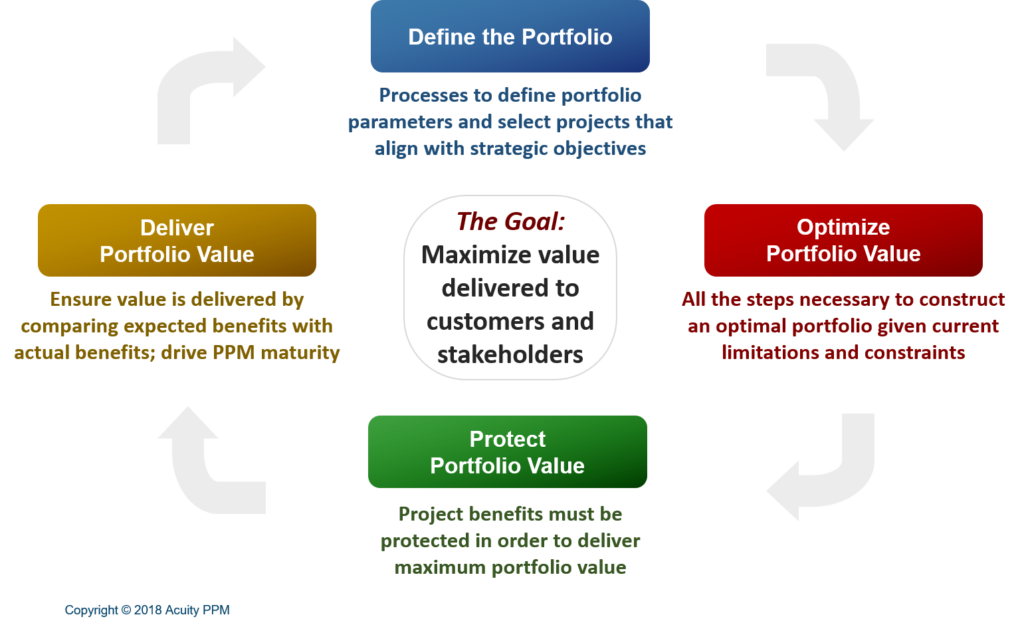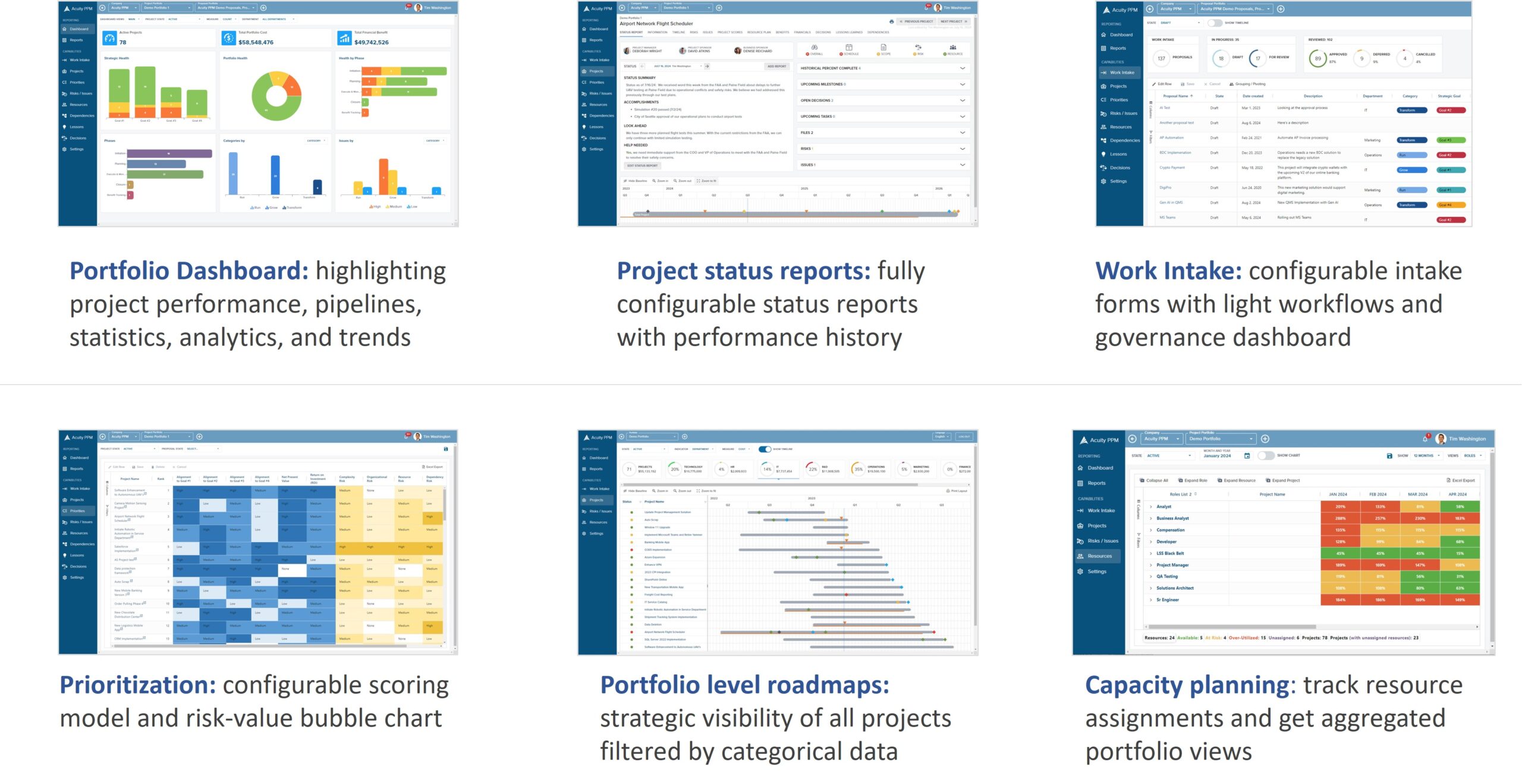PPM 101: What Is Project Portfolio Management?
What is Project Portfolio Management (PPM)?
Project portfolio management (hereafter referred to as “PPM”) is a critical component for executives and senior managers to execute strategy. According to Mark Morgan, “there is simply no path to executing strategy other than the one that runs through project portfolio management”. In fact, projects are “the true traction point for strategic execution”. Furthermore, David Cleland states in the book Project Portfolio Management: Selecting and Prioritizing Projects for Competitive Advantage by Lowell D. Dye and James S. Pennypacker that “projects are essential to the survival and growth of organizations. Failure in project management in an enterprise can prevent the organization from accomplishing its mission. The greater the use of projects in accomplishing organizational purposes, the more dependent the organization is on the effective and efficient management of those projects. Projects are a direct means of creating value for the customer in terms of future products and services. The pathway to change will be through development and process projects. …With projects playing such a pivotal role in future strategies, senior managers must approve and maintain surveillance over these projects to determine which ones can make a contribution to the strategic survival of the company”. Every Project Management Office (PMO) should be heavily involved with project portfolio management.
The Distinction Between Project, Program, and Portfolio Management
Before diving into the details of project portfolio management, let’s provide a brief overview of the difference between projects, programs, and portfolios.

- PORTFOLIO: a portfolio is a collection of projects and programs
- PROGRAM: a program is a collection of related projects and other work that share common objectives and are better managed collectively
- PROJECT: a temporary endeavor undertaken to create a unique product, service or result with defined scope resources, and schedule.
Project portfolio management is a senior leadership discipline that drives strategic execution and maximizes business value delivery through the selection, optimization, and oversight of project investments which align to business goals and strategies
Portfolio Management Definitions
First, project portfolio management must be defined. Several definitions of PPM from authoritative resources are given below and provide a balanced view to the subject of portfolio management. Without a complete understanding of PPM, the benefits mentioned above will be reduced.
According to the Project Management Institute (PMI®), project portfolio management is the “centralized management of one or more portfolios that enable executive management to meet organizational goals and objectives through efficient decision making on portfolios, projects, programs and operations.”
The Stanford Advanced Project Management series offers a concise definition of PPM: “Portfolio management is the strategy-based, prioritized set of all projects and programs in an organization reconciled to the resources available to accomplish them”.
The Association for Project Management defines portfolio management as “the selection, prioritization and control of an organisation’s projects and programs in line with its strategic objectives and capacity to deliver. The goal is to balance change initiatives and business-as-usual while optimizing return on investment”.
Gaylord Wahl of Point B provides another angle of portfolio management: “Project portfolio management applies the tools and discipline of financial management to product/project management, taking into account: investment strategy, risk, ROI, growth/profitability, balance, diversification, and alignment to goals.”
Acuity PPM defines portfolio management as “a senior leadership discipline that drives strategic execution and maximizes business value delivery through the selection, optimization, and oversight of project investments which align to business goals and strategies”. PPM is about maximizing and delivering value.
What Is the Project Portfolio Management Lifecycle?
Based on the information above, project portfolio management can be broken down into four basic components: selecting the right projects, optimizing the portfolio, protecting the portfolio’s value, and improving portfolio processes. In order to implement portfolio management, we must understand PPM at this highest level. These four components are represented in the diagram below, but it is important to understand that these four lifecycle steps occur in parallel with each other, but for the purpose of understanding portfolio management, we can define four distinct lifecycle steps.

1) Define the Portfolio— Defining the portfolio includes process such as ideation, work intake, and Phase-Gate to select projects that align with strategic objectives. Part of portfolio definition requires the governance team to define portfolio parameters such what types of projects to include (e.g. operational projects, strategic projects, or both), the dollar threshold at which point projects should be included in the portfolio. At the beginning of implementing portfolio management, it is important for the governance team to decide what a project is and then define which types of projects belong in the portfolio. This results in the portfolio containing a higher percentage of winning projects.
2) Optimize Portfolio Value—this involves all the steps necessary to construct an optimal portfolio given current limitations and constraints (e.g. prioritization, resource capacity planning, portfolio planning, etc.). Portfolio optimization involves intermediate to advanced processes to maximize the value of the portfolio. Governance teams first need to establish Work Intake processes and be able to say no to new requests. Once basic governance is established, it is possible to truly optimize the portfolio. By definition, portfolio optimization means working within current limitations and constraints, and in practice it requires governance teams to reject lower value work in order to increase the overall value of the portfolio.
3) Protect Portfolio Value—during the execution of an optimized portfolio, the aggregate project benefits (portfolio value) must be protected. This occurs by monitoring projects, assessing portfolio health, and managing portfolio risk. It is not enough merely to initiate good projects, senior leadership plays an important role in ensuring that projects meet their intended objectives and deliver the expected value. Some of this responsibility falls on the project sponsor and project steering committee, but the portfolio governance team plays an even greater role to ensure that resources are available for in-flight work, there are no competing priorities that frustrate project completion, and portfolio level risks are addressed.
4) Deliver Portfolio Value—Part of this lifecycle phase involves benefits realization processes to ensure that portfolio value is delivered by comparing expected benefits with actual benefits. This requires teams to proactively measure project performance post-completion. Many companies do not devote resources to benefit realization and therefore miss an opportunity to compare expected benefits against actual benefits. In addition, delivering portfolio value involves improving PPM maturity as higher maturity translates into a greater realization of the benefits of portfolio management. Lastly, ongoing process improvement can improve portfolio delivery.
What Are The Important PPM Capabilities?
Project portfolio management is a multi-faceted strategic discipline that includes a number of capabilities. Each of these capabilities is covered in more detail in the presentation at the bottom of the page. Portfolio Managers are needed to both develop and oversee these processes.
- Ideation – the process to generate and affinitize a list of new project ideas. The goal is to collect the best ideas from the organization to generate higher quality projects.
- Work Intake – refers to the steps of developing a project proposal and bringing it to the governance board for a go/no-go decision.
- Phase-Gate – a governance structure to evaluate, authorize, and monitor projects as they pass through the project lifecycle.
- Prioritization – the process of evaluating project value in order to assign resources to the most important projects and start work at the appropriate time
- Portfolio Optimization – refers to optimization techniques used to identify the optimal grouping of projects that maximize the risk-adjusted portfolio value at a given budgetary level
- Portfolio Planning – the process to optimize the sequencing and timing of approved projects based on resource constraints and dependencies
- Resource Capacity Planning – the process of comparing future resource utilization of project resources against available capacity to do work
- Portfolio Risk Management – assesses the risk nature of projects and manages portfolio level risks
- Portfolio Communication – processes to communicate about all aspects of project and portfolio progress
- Portfolio Management Charts, Reports, and Analytics – processes to analyze and report against the value and progress of the portfolio
- Portfolio Value Management – processes to evaluate, measure, and track project benefits at the portfolio level
- Project Monitoring – processes to measure and track project health and performance
- Portfolio Governance – the decision making process to select and prioritize project work

When Is It Time To Implement PPM?
There are several signals for when companies should implement project portfolio management.
- The first indicator for when companies should implement PPM is when they start managing multiple projects. Senior leadership should get visibility of the project portfolio right away; this is important for managing strategy execution and guarding against low value projects.
- If it is hard to get work done, there are competing priorities (or the priorities change often), and resources are overworked, this is another good indicator to implement basic portfolio management practices.
- If the organization is overloaded with work, and priorities are unclear, this is another indicator to adopt portfolio management practices.
- Senior leaders who want to improve their strategy execution should institute basic portfolio management rigor.
Get Answers to Fundamental Questions
Project portfolio management provides answers to eight fundamental questions:
- What are we working on? You cannot manage what you cannot see. Organizations with little or no portfolio management discipline may be running far more projects than they realize, or even worse, may be managing duplicate project efforts and not even realize it. Getting visibility of all project work is the first major benefit of tracking your project portfolio. This helps senior leadership eliminate redundant projects and save money.
- Do we have the right projects? After getting visibility of all project work, the leadership team can begin to evaluate whether they have the right projects in the portfolio. This requires establishing good criteria for what constitutes a “good” project. Leadership should also develop an intake process to evaluate and approve the right project work.
- Where are we investing money and people? Without good portfolio level metrics and analytics, senior leadership may be blind to where they are investing resources across the portfolio. There are many ways to evaluate where money and people are being invested. This is why it is important to categorize projects. One common approach is “Run”, “Grow”, and “Transform”. Categories such as these can greatly inform leadership of how many money is being spent to run the business versus growing or transforming the business.
- Is our portfolio optimized? Optimizing a portfolio requires understanding the various budgetary or resource constraints of the organization. This is an advanced process to ensure the greatest “bang for the buck”. Portfolio optimization happens on multiple levels such as cost-value optimization, resource optimization, schedule optimization, and work-type optimization.
- Can we realistically deliver the portfolio? This is an important question that senior leadership needs answers for. When companies do not operate within known resource constraints and/or do not have realistic project plans in place, it is impossible to successfully deliver the portfolio of work according to plan.
- How are we performing? Understanding actual portfolio performance is critical for senior leadership to successfully and consistently “deliver the goods”. This includes project status, but goes beyond the individual project status report and requires an aggregate portfolio view of project performance in order to get an accurate picture of how the portfolio is performing.
- Can we absorb all the change? Even if resources are managed well and good project plans are in place, if a lot of projects try to implement multiple changes to the same stakeholder group at the same time, that organization or company may not be able to absorb and handle all the changes coming at them. Good portfolio management will monitor whether the organization can absorb all the changes.
- Did we get the benefits we intended? This refers to benefit realization and is an important topic. In order to know whether the benefits were realized after the project, the leadership team needs to understand what the benefits are before the project starts and track them throughout the project lifecycle.
By implementing project portfolio management, your company can get answers to these questions faster and with greater confidence.
What Are The Benefits of Portfolio Management?
Companies that do successfully implement project portfolio management (PPM) reap several benefits, listed below:
- Greater strategic execution resulting in the accomplishment of more business goals and objectives of the organization
- Maximized portfolio value for the organization
- Enhanced decision making processes resulting in better decisions
- Successful management of organizational change
- Greater visibility of projects in the organization
- Higher success rate of projects within a complex environment
- Reduced organizational risk
- Balanced project portfolio workload
These benefits are real, but require leadership to endorse portfolio management practices and follow defined procedures in order to get organizational buy-in and support.
Acuity PPM Project Portfolio Management Software
Acuity PPM is an excellent lightweight project portfolio management solution that replaces spreadsheets. Acuity PPM helps you track project performance, report project and portfolio status to senior leaders, manage and prioritize incoming project requests, visualize strategic roadmaps, allocate resources and manage resource capacity. All of this helps enable strategic agility in a changing environment.

[activecampaign form=3]
Tim is a project and portfolio management consultant with over 15 years of experience working with the Fortune 500. He is an expert in maturity-based PPM and helps PMO Leaders build and improve their PMO to unlock more value for their company. He is one of the original PfMP’s (Portfolio Management Professionals) and a public speaker at business conferences and PMI events.
An Overview of PPM
This presentation will teach you the foundational principles of PPM.
For a free copy of this presentation, just sign up now.
What is a project portfolio?
A project portfolio is a defined set of projects and programs within an organization that is better managed as a collective set of work to accomplish strategic goals.
What is project portfolio management?
Project portfolio management is a senior leadership discipline that drives strategic execution and maximizes business value delivery through the selection, optimization, and oversight of project investments which align to business goals and strategies.
What is the portfolio management lifecycle?
The portfolio management lifecycle includes four essential elements. 1) Define the Portfolio— Processes to define portfolio parameters and select projects that align with strategic objectives. This results in the portfolio containing a higher percentage of winning projects. 2) Optimize Portfolio Value—all the steps necessary to construct an optimal portfolio given current limitations and constraints (e.g. prioritization, resource capacity planning, portfolio planning, etc.) 3) Protect Portfolio Value—during the execution of an optimized portfolio, the aggregate project benefits (portfolio value) must be protected. This occurs by monitoring projects, assessing portfolio health, and managing portfolio risk. 4) Deliver Portfolio Value—Ensure that portfolio value is delivered by comparing expected benefits with actual benefits. Improving PPM maturity translates into a greater realization of the benefits of portfolio management.
What are important project portfolio management capabilities?
The full breadth of project portfolio management includes several important capabilities including: ideation, work intake, Stage-Gate, prioritization, portfolio optimization, portfolio planning, resource capacity planning, portfolio risk management, portfolio communication, portfolio reporting and analytics, portfolio value management, project monitoring, and portfolio governance.
What are the benefits of project portfolio management?
Companies that do successfully implement project portfolio management (PPM) reap several benefits: 1) Greater strategic execution resulting in the accomplishment of more business goals and objectives of the organization 2) Maximized portfolio value for the organization 3) Enhanced decision making processes resulting in better decisions 4) Successful management of organizational change 5) Greater visibility of projects in the organization 6) Higher success rate of projects within a complex environment 7) Reduced organizational risk 8) Balanced project portfolio workload
What are important project portfolio management questions to answer?
1. What are we working on? 2. Do we have the right projects? 3. Where are we investing money and people? 4. Is our portfolio optimized? 5. Can we realistically deliver the portfolio? 6. How are we performing? 7. Can we absorb all the change? 8. Did we get the benefits we intended?
Never miss an Acuity PPM article
Don't take our word, listen to what others are saying:
"I find value in all of your articles."
"Your articles are interesting and I am sharing them with my team who have limited project knowledge. They are very useful."


